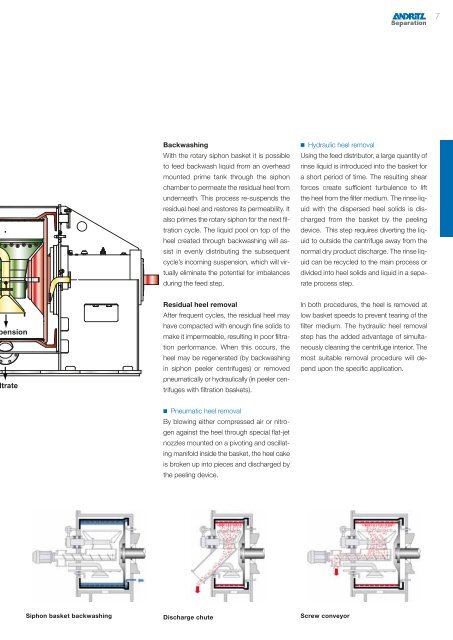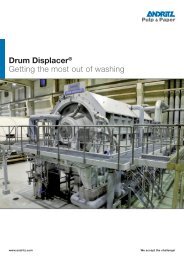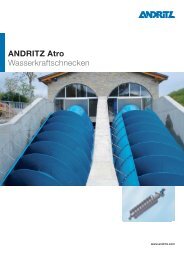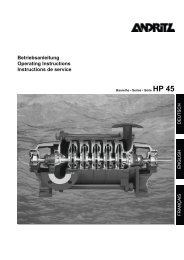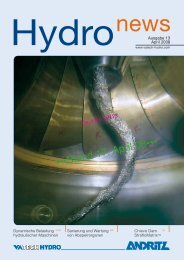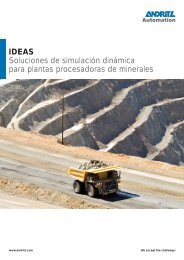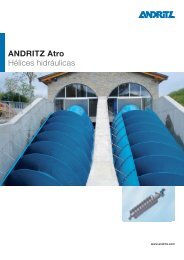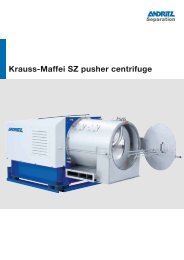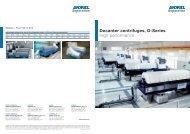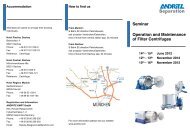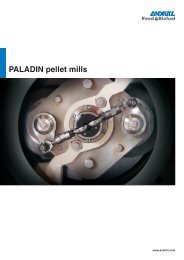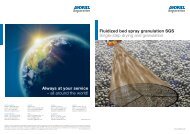Krauss-Maffei HZ peeler centrifuge - Andritz
Krauss-Maffei HZ peeler centrifuge - Andritz
Krauss-Maffei HZ peeler centrifuge - Andritz
You also want an ePaper? Increase the reach of your titles
YUMPU automatically turns print PDFs into web optimized ePapers that Google loves.
ension<br />
trate<br />
Backwashing<br />
With the rotary siphon basket it is possible<br />
to feed backwash liquid from an overhead<br />
mounted prime tank through the siphon<br />
chamber to permeate the residual heel from<br />
underneath. This process re-suspends the<br />
residual heel and restores its permeability. It<br />
also primes the rotary siphon for the next filtration<br />
cycle. The liquid pool on top of the<br />
heel created through backwashing will assist<br />
in evenly distributing the subsequent<br />
cycle’s incoming suspension, which will virtually<br />
eliminate the potential for imbalances<br />
during the feed step.<br />
Residual heel removal<br />
After frequent cycles, the residual heel may<br />
have compacted with enough fine solids to<br />
make it impermeable, resulting in poor filtration<br />
performance. When this occurs, the<br />
heel may be regenerated (by backwashing<br />
in siphon <strong>peeler</strong> <strong>centrifuge</strong>s) or removed<br />
pneumatically or hydraulically (in <strong>peeler</strong> <strong>centrifuge</strong>s<br />
with filtration baskets).<br />
■ Pneumatic heel removal<br />
By blowing either compressed air or nitrogen<br />
against the heel through special flat-jet<br />
nozzles mounted on a pivoting and oscillating<br />
manifold inside the basket, the heel cake<br />
is broken up into pieces and discharged by<br />
the peeling device.<br />
Siphon basket backwashing Discharge chute Screw conveyor<br />
■ Hydraulic heel removal<br />
Using the feed distributor, a large quantity of<br />
rinse liquid is introduced into the basket for<br />
a short period of time. The resulting shear<br />
forces create sufficient turbulence to lift<br />
the heel from the filter medium. The rinse liquid<br />
with the dispersed heel solids is discharged<br />
from the basket by the peeling<br />
device. This step requires diverting the liquid<br />
to outside the <strong>centrifuge</strong> away from the<br />
normal dry product discharge. The rinse liquid<br />
can be recycled to the main process or<br />
divided into heel solids and liquid in a separate<br />
process step.<br />
In both procedures, the heel is removed at<br />
low basket speeds to prevent tearing of the<br />
filter medium. The hydraulic heel removal<br />
step has the added advantage of simulta-<br />
neously cleaning the <strong>centrifuge</strong> interior. The<br />
most suitable removal procedure will de-<br />
pend upon the specific application.<br />
7


